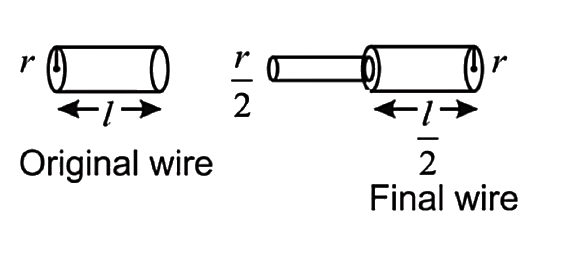One end of a horizontal thick copper wire of length 2L and radius 2R is welded to an end fo another horizontal thin copper wire of lenth L and radius R. When the arrangement is stretched by applying forces at two ends, the ratio of the elongation in the thin wire to that in the thick wire is
(a) 0.25
(b) 0.50
(c) 2.00
(d) 4.00
The correct Answer is:C
To find the ratio of the elongation in the thin wire to that in the thick wire, we can use the concept of Young's modulus. Let's break down the solution step by step.
Step 1: Understand the setup
We have two wires:
- A thick wire of length 2L and radius 2R.
- A thin wire of length L and radius R.
Both wires are made of copper and are welded together at one end. When a force F is applied at both ends, we need to find the ratio of elongation in the thin wire (ΔL2) to that in the thick wire (ΔL1).
Step 2: Write the formula for Young's modulus
The Young's modulus Y is defined as:
Y=F/AΔL/L
where F is the force applied, A is the cross-sectional area, ΔL is the change in length (elongation), and L is the original length of the wire.
Step 3: Calculate the cross-sectional areas
- For the thick wire:
A1=π(2R)2=4πR2
- For the thin wire:
A2=πR2
Step 4: Set up the equations for Young's modulus for both wires
For the thick wire:
Y=FA1⋅LΔL1⇒Y=F4πR2⋅2LΔL1
Rearranging gives:
ΔL1=F⋅2LY⋅4πR2
For the thin wire:
Y=FA2⋅LΔL2⇒Y=FπR2⋅LΔL2
Rearranging gives:
ΔL2=F⋅LY⋅πR2
Step 5: Find the ratio of elongations
Now, we can find the ratio ΔL2ΔL1:
ΔL2ΔL1=F⋅LY⋅πR2F⋅2LY⋅4πR2
Step 6: Simplify the ratio
Cancelling out common terms:
ΔL2ΔL1=4πR22πR2=42=2
Conclusion
Thus, the ratio of the elongation in the thin wire to that in the thick wire is:
ΔL2ΔL1=2
Final Answer
The ratio of the elongation in the thin wire to that in the thick wire is 2:1.
---
We have two wires:
- A thick wire of length 2L and radius 2R.
- A thin wire of length L and radius R.
The Young's modulus Y is defined as:
Y=F/AΔL/L
where F is the force applied, A is the cross-sectional area, ΔL is the change in length (elongation), and L is the original length of the wire.
- For the thick wire:
A1=π(2R)2=4πR2
- For the thin wire:
A2=πR2
For the thick wire:
Y=FA1⋅LΔL1⇒Y=F4πR2⋅2LΔL1
Rearranging gives:
ΔL1=F⋅2LY⋅4πR2
Y=FA2⋅LΔL2⇒Y=FπR2⋅LΔL2
Rearranging gives:
ΔL2=F⋅LY⋅πR2
Now, we can find the ratio ΔL2ΔL1:
ΔL2ΔL1=F⋅LY⋅πR2F⋅2LY⋅4πR2
Cancelling out common terms:
ΔL2ΔL1=4πR22πR2=42=2
Thus, the ratio of the elongation in the thin wire to that in the thick wire is:
ΔL2ΔL1=2
The ratio of the elongation in the thin wire to that in the thick wire is 2:1.
Topper's Solved these Questions
- MECHANICAL PROPERTIES OF MATTER AND FLUIDSBOOK - SUNIL BATRA (41 YEARS IITJEE PHYSICS)CHAPTER - MECHANICAL PROPERTIES OF MATTER AND FLUIDSEXERCISE - Subjective Problems
1 Videos
- LAWS OF MOTIONBOOK - SUNIL BATRA (41 YEARS IITJEE PHYSICS)CHAPTER - LAWS OF MOTIONEXERCISE - JEE Main And Advanced
79 Videos
- MOMENTUM & IMPULSEBOOK - SUNIL BATRA (41 YEARS IITJEE PHYSICS)CHAPTER - MOMENTUM & IMPULSEEXERCISE - JEE Main And Advanced
30 Videos
Similar Questions
A wire of length l has a resistance R. If half of the length is stretched to make the radius half of its original value, then the final resistance of the wire is

View SolutionTwo copper wires have equal length but the thickness of one is twice that of the other. If the resistance of the thin wire is 10Ω, find the resistance of the thick wire.
View Solution
Knowledge Check
One end of a horizontal thick copper wire of length 2L and radius 2R is weded to an end of another horizontal thin copper wire of length L and radius R .When the arrangement is stretched by applying forces at two ends , the ratio of the elongation in the thin wire to that in the thick wire is
A0.25B0.50C2.00D4.00A wire of initial length L and radius r is stretched by a length l. Another wire of same material but with initial length 2L and radius 2r is stretched by a length 2l. The ratio of the stored elastic energy per unit volume in the first and second wire is?
A1:4B1:2C2:1D1:1A copper wire of length 1m and radius is joined in series with an iron wire of length 2m and radius 3mm and a current is passed through the wire. The ratio of the current density in the copper and iron wires is
A18:1B9:1C6:1D2:3
Two copper wires have equal length but the thickness of one is twice that of the other. If the resistance of the thin wire is 10Ω, find the resistance of the thick wire.
View SolutionA force F is needed to break a copper wire having radius R. The force needed to break a copper wire of same length and radius 2R will be
View SolutionA wire of length L and radius r suspended from rigid support of mass M gm be applied its free end, its elongation is l, then its Young's modulus is
View SolutionOne end of a Nichrome wire of length 2L and cross-sectional area A is attatched to an end of another Nichrome wire of length L and cross-sectional area 2A. If the free end of the longer wire is at an electric potential of 8.0 volts, and the free end of the shorter wire is at an electric potential 1.0 volts, the potential at the junction of the two wires is equal to
View SolutionA wire of length L and radius r is fixed at one end. When a stretching force F is applied at free end, the elongation in the wire is l. When another wire of same material but of length 2L and radius 2r, also fixed at one end is stretched by a force 2F applied at free end, then elongation in the second wire will be
View Solution
